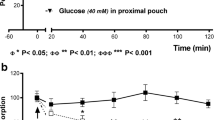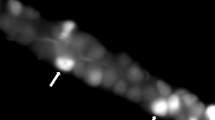Abstract
Somatostatin, secretin, and glucagon have been shown to inhibit gastric acid secretionin vivo and thus have been postulated to act directly on the parietal cell. To test the hypothesis that these peptides directly influence the acid secretory cells, we studied the effect of the three gastrointestinal hormones using aminopyrine uptake as an index of acid production. The parietal cells were stimulated to increase aminopyrine uptake by submaximal concentrations of histamine (10−6 mol/l), methacholine (10−6 mol/l), and pentagastrin (10−6 mol/l), but in no concentrations did these gastrointestinal hormones affect any of the secretagogues' response. Our data suggest that gastrointestinal peptides do not modulate acid secretion at the parietal cell level.
Similar content being viewed by others
References
P. Brazeau, W. Vale, R. Burgus, N. Ling, M. Butcher, J. Rivier andR. Guillemin,Hypothalamic polypeptide that inhibits the secretion of immunoreactive pituitary growth hormone, Science179, 77–79 (1973).
A. Arimura, H. Sato, A. DuPont, N. Nishi andA.V. Schally,Somatostatin: abundance of immuno-reactive hormone in rat stomach and pancreas, Science189, 1007–1009 (1975).
C. Rufener, M.P. Dubois, F. Malaisse-Lagae andL. Orci,Immuno-fluorescent reactivity to anti-somatostatin in the gastrointestinal mucosa of the dog, DiabetologiaII, 321–324 (1975).
L-I. Larsson, N. Goltermann, L. de Magistris, J.F. Rehfeld andT.W. Schwartz,Somatostatin cell processes as pathways for paracrine secretion, Science205, 1393–1394 (1979).
V. Schusdziarra, V. Harris, J.M. Conlon, A. Arimura andR. Unger,Pancreatic and gastric somatostatin release in response to intragastric and intraduodenal nutrients and HCl in the dog, J. clin. Invest.62, 509–518 (1978).
B. Saffouri, G. Weir, K. Bitar andG. Makhlouf,Stimulation of gastrin secretion from the perfused rat stomach by somatostatin antiserum, Life Sci.25, 1749–1754 (1979).
S.J. Konturek, J. Tasler, M. Cieszkowski, D.H. Coy andA.V. Schally,Effect of growth hormone release-inhibiting hormone on gastric secretion, mucosal blood flow, and serum gastrin, Gastroenterology70, 737–741 (1976).
J. Phillip, S. Domschke, W. Domschke, H.-J. Urbach, M. Reiss andL. Demling,Inhibition by somatostatin of gastrin release and gastric acid responses to meals and to pentagastrin in man, Scand. J. Gastroent.12, 261–265 (1977).
W.E.G. Thomas,Inhibitory effect of somatostatin on gastric acid secretion and serum gastrin in dogs with and without duodenogastric reflux, Gut21, 996–1001 (1980).
M. Albinus, J.D. Reed, A. Gomez-Pan, A.V. Schally andD.H. Coy,Comparison of the inhibition of histamine- and pentagastrin-stimulated gastric acid secretion by somatostatin in the cat, Agents and Actions7, 501–506 (1977).
H. Hummelt, H.M. Jennewein, R. Treichel andF. Waldeck,Somatostatin mode of action on gastric acid secretion in dogs, Digestion15, 151–155 (1977).
M.J. Robein, M.C. de la Mare, J.M. Dubrasquet andS. Bonfils,Utilization of the perfused stomach in anaesthetized rats to study the inhibitory effect of somatostatin in gastric acid secretion, Agents and Actions9, 415–421 (1979).
H.A. El Munshid, R. Håkanson, G. Liedberg andF. Sundler,Effects of various gastrointestinal peptides on parietal cells and endocrine cells in the oxyntic mucosa of rat stomach, J. Physiol.305, 249–265 (1980).
A.A.J. Barros D'Sa, S.R. Bloom andJ.H. Baron,Direct inhibition of gastric acid by growth-hormone release-inhibiting hormone in dogs, Lancet1, 886–887 (1975).
A. Gomez-Pan, J.D. Reed, M. Albinus, B. Shaw, R. Hall, G.M. Besser, D.H. Coy, A.J. Kastin andA.V. Schally,Direct inhibition of gastric acid and pepsin secretion by growth-hormone release-inhibiting hormone in cats, Lancet1, 888–890 (1975).
P.G. Kulkarni, F.M. Hoffman andR.L. Shoemaker,Inhibition of H + secretion in frog gastric mucosa by somatostatin, Am. J. Physiol.236, E784-E787 (1979).
S.J. Konturek, J. Biernat, N. Kwiecien andJ. Oleksy,Effect of glucagon on meal-induced gastric secretion in man, Gastroenterology68, 448–454 (1975).
H.D. Becker, D.D. Reeder andJ.C. Thompson,Effect of glucagon on circulating gastrin, Gastroenterology65, 28–35 (1973).
J.C. Thompson, D.D. Reeder, H.H. Bunchman, H.D. Becker andE.N. Brandt,Effect of secretion on circulating gastrin, Ann. Surg.176, 384–392 (1972).
M.D. Dalton, A.M. Eisenstein, J.H. Walsh andJ.S. Fordtran,Effect of secretin on gastric function in normal subjects and in patients with duodenal ulcer, Gastroenterology71, 24–29 (1976).
A.H. Soll,The actions of secretagogues on oxygen uptake by isolated mammalian parietal cells, J. clin. Invest.61, 370–380 (1978).
T. Berglindh, H.F. Helander andK.J. Obrink,Effects of secretagogues on oxygen consumption, aminopyrine accumulation and morphology in isolated gastric glands, Acta Physiol. Scand.97, 401–414 (1976).
J.F. Gerkens, J.G. Gerber, D.G. Shand andR.A. Branch,Effect of PGI 2,PGE 2 and 6 keto PGF 1α on canine gastric blood flow and acid secretion, Prostaglandins16, 815–823 (1978).
A.H. Soll,Specific inhibition by prostaglandins E 2 and I 2 of histamine stimulated 14 C aminopyrine accumulation and cyclic adenosine monophosphate generation by isolated canine parietal cells, J. clin. Invest.65, 1222–1229 (1980).
H.-J. Rouff andS. Maslinski,Stimulation and inhibition of aminopyrine-uptake in isolated rat gastric mucosal cells. Naunyn-Schmiedebergs Arch. exp. Path. Pharmak.319 (suppl): R56 (1982).
Author information
Authors and Affiliations
Additional information
This work was supported by a grant from the Public Health Service HL 21308. Dr Gerber is an Established Investigator of the American Heart Association.
Rights and permissions
About this article
Cite this article
Perez-Reyes, E., Payne, N.A. & Gerber, J.G. Effect of somatostatin, secretin, and glucagon on secretagogue stimulated aminopyrine uptake in isolated canine parietal cells. Agents and Actions 13, 265–268 (1983). https://doi.org/10.1007/BF01971476
Received:
Issue Date:
DOI: https://doi.org/10.1007/BF01971476




